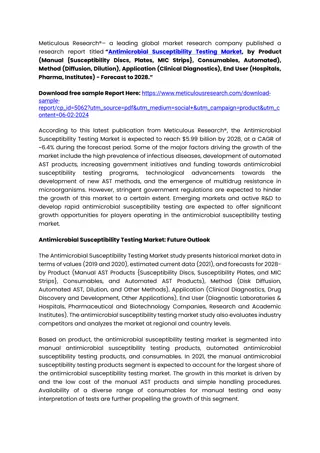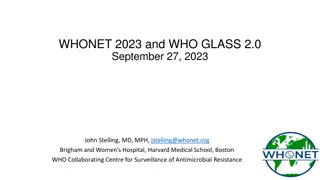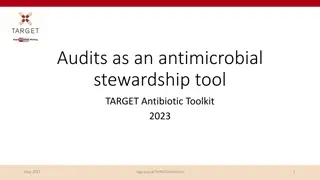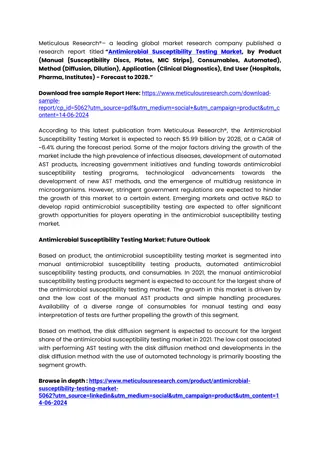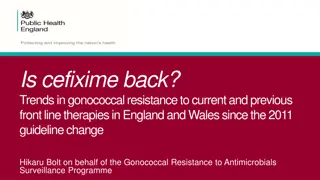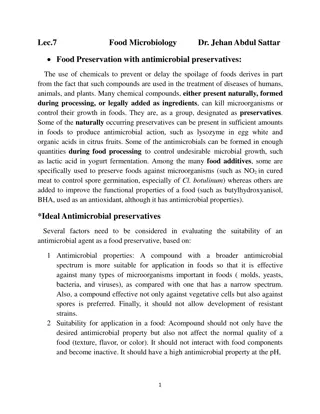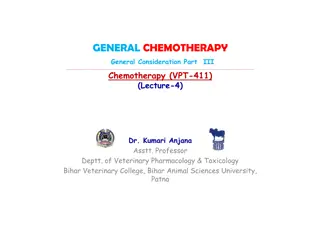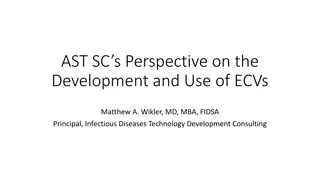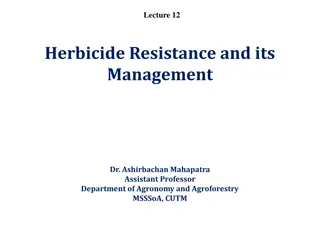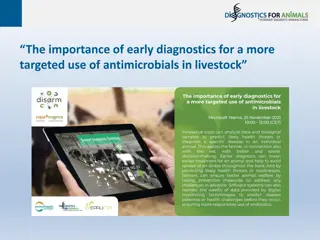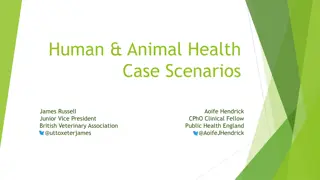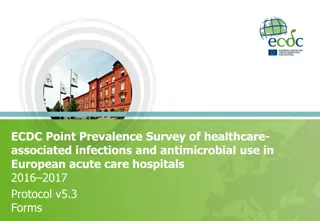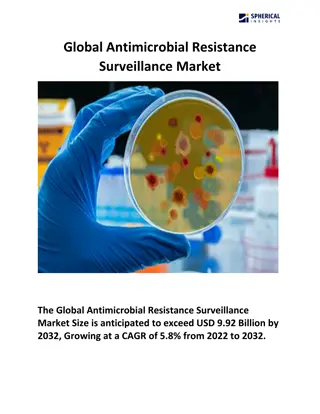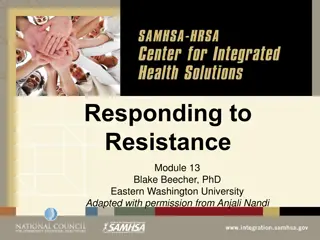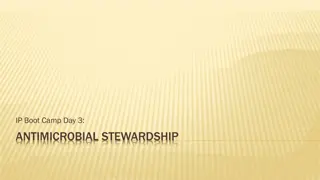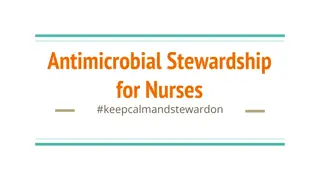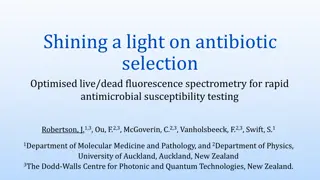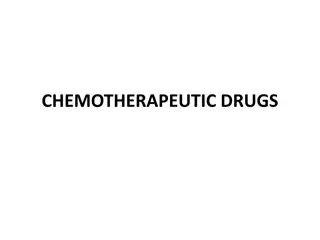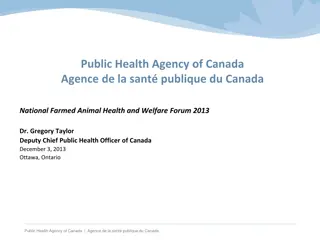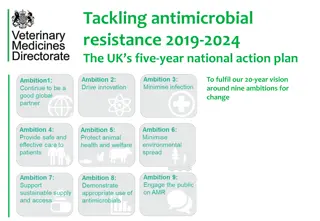Combatting Antimicrobial Resistance: A Comprehensive Approach
Infectious Diseases class covers topics such as antibiotic stewardship, bacterial infections, viral diseases, and more. Cautionary statements by Sir Alexander Fleming underline the dangers of antimicrobial resistance, predicting millions of deaths and trillions in economic costs by 2050. The consequences of resistance include longer illnesses, higher mortality, and burden on healthcare systems. The solution involves new drug discovery, infection control, antibiotic policy, and optimized therapy.
Download Presentation

Please find below an Image/Link to download the presentation.
The content on the website is provided AS IS for your information and personal use only. It may not be sold, licensed, or shared on other websites without obtaining consent from the author.If you encounter any issues during the download, it is possible that the publisher has removed the file from their server.
You are allowed to download the files provided on this website for personal or commercial use, subject to the condition that they are used lawfully. All files are the property of their respective owners.
The content on the website is provided AS IS for your information and personal use only. It may not be sold, licensed, or shared on other websites without obtaining consent from the author.
E N D
Presentation Transcript
Infectious diseases 4/5thSemester Classes on Infectious Diseases, 8-9AM, Tuesdays (LT-1) Topics Approach to Infectious Diseases and their prevention 1 Antibiotic stewardship practices 2 Community-Acquired Infections 3 Health Care Associated Infections 4 Gram-Positive Bacteria (part-1) 5 Gram-Positive Bacteria (part-2) 6 Gram-Negative Bacteria (part-1) 7 Gram-Negative Bacteria (part-2) 8 Spirochetal Diseases 9 Diseases Caused by Atypical/Miscellaneous Bacterial Infections 10 Revision-cum-exam on bacteria (Must to know type) 11 1 Infections Due to DNA Viruses 12 Infections Due to RNA Viruses (part 1) 13 Infections Due to RNA Viruses (part 2) 14 HIV/AIDS part 1 15 HIV/AIDS part 2 16 Dr. P. K. Panda, 17 Fungal Infections Asst. Professor 18 Parasitic Infections (part 1) Department of Medicine 19 Parasitic Infections (part 2) AIIMS, Rishikesh 20 Revision-cum-exam on Virus, Fungal, and Parasite (Must to know type)
Cautionary statements by Sir Alexander Fleming in 1945, ... the microbes are educated to resist penicillin and a host of penicillin-fast organisms is bred out....In such cases the thoughtless person playing with penicillin is morally responsible for the death of the man who finally succumbs to infection with the penicillin- resistant organism. I hope this evil can be averted
Potential impact of antimicrobial resistance if left unchecked By 2050 more than 10 million people across the globe could be dying per year as the result of an antimicrobial resistant infection. (More than currently dying because of cancer.) Economic cost cumulatively to be more than $100 trillion US. Equates to burning $15,000 US for every man, woman, and child on the planet.
Consequences of Resistance Longer duration of illness Increased HAI Higher mortality Treatment with expensive drugs Increased burden on the health system Patient acts as a reservoir of resistant organisms for the community Estimates of Overuse, Misuse, Abuse Antimicrobials account for 30-50% of hospital pharmacy budgets. Up to 50% of antimicrobial use is inappropriate.
Another Problem Antimicrobial resistance is increasing while the development of newer antimicrobial is decreasing.
What is the solution? New drug discovery and manufacture 10 x 20 initiative: Highly challenging Reduce cross-infections: Infection Control practices Preserve efficacy of available antimicrobials: Antibiotic policy Optimize therapy: Antibiotic stewardship
Antimicrobial Stewardship Coordinated interventions designed to improve and measure the appropriate use of antimicrobials by promoting the selection of the optimal antimicrobial drug regimen, dose, duration of therapy, and route of administration. Stewardship: the careful and responsible management of natural resources
Antimicrobial Stewardship Philosophy 1. Optimizing clinical outcomes 2. Minimizing unintended consequences of antimicrobial use Toxicity. Selection of pathogenic organisms such as Clostridium difficile. Emergence of resistance. Other adverse events 3. Reducing healthcare costs without adversely impacting the quality of care.
BUILDING THE STEWARDSHIP TEAM Team Members A mistake to delay implementation because of a lack of availability of participants Infectious disease physicians - Only handful in entire country. Clinical pharmacist - Only involved in dispensing Clinical microbiologist - Mostly confined to labs Infection control professional/ nurse - No formal training Hospital epidemiologists - Non-existent
Work of a stewardship team Surveillance of prescribing practice and clinical outcomes Antibiotic use (various measures of quantities) Ecological impacts (antibiotic resistance development and Clostridium difficile infection numbers) Clinical outcomes (morbidity and mortality rates). Design and implementation of interventions aimed at optimal antibiotic prescribing Structural Restrictive Persuasive
Stewardship Interventions Front-end / pre-prescription authorization approach (Restrictive) Back-end / post-prescription review and feedback approach (Persuasive) Most successful programs generally implement a combination of both
Front-end/pre-prescription authorization approach Uses restrictive prescriptive authority Certain antimicrobials are considered restricted and require prior authorization for use by all except a select group of clinicians. For others approval from the steward will be required
Back-end/post-prescription review and feedback Reviews all current antibiotic orders and provides clinicians with recommendations to continue, adjust, change, or discontinue therapy based on the available microbiology results and clinical features of case. Example- In a large teaching hospital, Resulted in a 37% reduction in the number of days of unnecessary levofloxacin or ceftazidime use by decreasing the duration of therapy, House staff learnt not to initiate unnecessary antibiotic treatment regimens.
Supplemental Antibiotic Stewardship Techniques Formulary restriction Treatment algorithm and clinical guidelines Education De-escalation Pharmacodynamic dose optimization IV to oral switch Computer surveillance and decision support Antibiotic cycling
Pocket or online guidebooks for clinicians, which contain empiric antibiotic recommendations for common infections, dosing guidelines etc.
Drug properties Pharmacokinetics (PK) What the body does to the drug Pharmacodynamics (PD) What the drug does to the body and microorganism
IV to Oral Switch Difficult to remember which medications are highly bio-available orally. Patients who are clinically stable and consuming a normal diet and other oral medications are automatically switched by pharmacists to oral drugs. Fluoroquinolones Clindamycin Rifampin Metronidazole Linezolid Macrolides (azithromycin, erythromycin) Fluconazole Doxycycline
Intravenous to oral switch Able to absorb? Oral option? Stable? Eating? Optimal antibiotics
Process and Outcome Measurements If you cannot measure; you cannot improve. -- Kelvin --
Process Measures Process measurements determine the degree to which the intervention to change the use of an antimicrobial has been successfully implemented, compared with baseline levels. Did the intervention result in the desired change in antimicrobial use? The units used are 1. Defined daily doses (DDD) 2. Days of therapy (DOT)
Outcome Measures Outcome measurements express the extent to which introduced changes have reduced resistance or other unintended consequences of antimicrobial use. Did the process implemented reduce or prevent resistance or other unintended consequences of antimicrobial use? Define the degree to which outcomes are altered (Point prevalence study) Antimicrobial resistance Adverse drug events Cost Unintended consequences, such as rates of C. difficile infection Clinical outcome variables- duration of hospitalization, mortality
Questions for front-line clinician Are antimicrobials indicated? If yes, what drug is the best choice? How can I limit the societal impact of this antimicrobial use?
Principles of Antibiotic Prescribing Microbiology guides therapy wherever possible Indications should be evidence based Narrowest spectrum required Dosage appropriate to the site and type of infection Minimise duration of therapy Ensure monotherapy in most cases
Drug prescription ............. ............. ............. Dose Route Duration
Diagnosti c work- up Therapeutic decisions Clinical re-assessment Clinical assessment Modify antimicrobials Data review Patient education Subsequent evaluation Initial evaluation
An informed choice Severity Drug resistance Patient factors Source Cultures Optimal antibiotics
An informed re-evaluation Review clinical & micro- biologic data Evaluate route & duration of therapy Check for adverse effects Assess spectrum Optimal antibiotics


